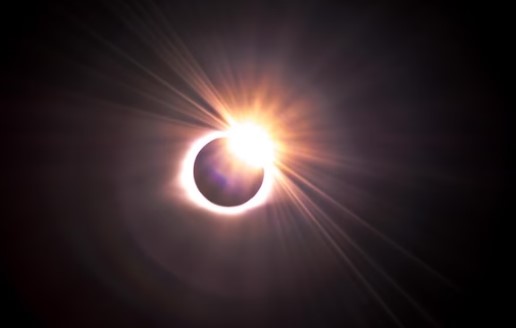Ningaloo Eclipse
2023 APR 25
Preliminary >
Geography > Cosmology > Cosmology

Why in news?
- The Ningaloo Eclipse was witnessed on April 20, 2023.
- The last one was seen in 2013, and the next one will appear in 2031.
About Ningaloo Eclipse:
- It is a rare ‘hybrid solar eclipse’, caused by the curvature of the earth's surface and a shift from annular to total eclipse.
- A total solar eclipse was visible in Australia, Timor-Leste and Indonesia (West Papua and Papua).
- At the same time, a partial solar eclipse was visible in Southeast Asia, East Indies, Australia, Philippines and New Zealand. It was not visible in India.
- Its uniqueness is such that it has already been named as Ningaloo, a part of western Australia from which the eclipse was most visible.
- The Ningaloo region is also designated as a UNESCO World Heritage Site.
What is Solar Eclipse?
- Solar eclipses occur when the Sun, the Moon, and Earth line up, either fully or partially. Depending on how they align, eclipses provide a unique, exciting view of either the Sun or the Moon.
- A solar eclipse happens when the Moon passes between the Sun and Earth, casting a shadow on Earth that either fully or partially blocks the Sun’s light in some areas.
- This only happens occasionally, because the Moon doesn't orbit in the exact same plane as the Sun and Earth do.
- The time when they are aligned is known as eclipse season, which happens twice a year.
Types of Solar Eclipse:
- Total Solar Eclipse:
- A total solar eclipse happens when the Moon passes between the Sun and Earth, completely blocking the face of the Sun. People located in the center of the Moon’s shadow when it hits Earth will experience a total eclipse. The sky will darken, as if it were dawn or dusk.
- Weather permitting, people in the path of a total solar eclipse can see the Sun’s corona, the outer atmosphere, which is otherwise usually obscured by the bright face of the Sun.
- A total solar eclipse is the only type of solar eclipse where viewers can momentarily remove their eclipse glasses (which are not the same as regular sunglasses) for the brief period of time when the Moon is completely blocking the Sun.
- Annular Eclipse:
- An annular solar eclipse happens when the Moon passes between the Sun and Earth, but when it is at or near its farthest point from Earth.
- Because the Moon is farther away from Earth, it appears smaller than the Sun and does not completely cover the Sun.
- As a result, the Moon appears as a dark disk on top of a larger, bright disk, creating what looks like a ring around the Moon.
- Partial Eclipse:
- A partial solar eclipse happens when the Moon passes between the Sun and Earth but the Sun, Moon, and Earth are not perfectly lined up. Only a part of the Sun will appear to be covered, giving it a crescent shape.
- During a total or annular solar eclipse, people outside the area covered by the Moon’s inner shadow see a partial solar eclipse.
- Hybrid Eclipse:
- Because Earth's surface is curved, sometimes an eclipse can shift between annular and total as the Moon’s shadow moves across the globe. This is called a hybrid solar eclipse.
Add ons:
- There are three types of lunar eclipses: total, partial, and penumbral.
- At least two partial lunar eclipses happen every year, but total lunar eclipses are rare.
- Unlike a solar eclipse, it is always safe to look at a lunar eclipse with the naked eye.
PRACTICE QUESTION:
Consider the following statements regarding ‘Ningaloo Eclipse’:
1. It is a type of solar eclipse
2. It is observable only from certain areas along the western coast of Australia.
Which of the statements given above is/are correct?
(a) 1 only
(b) 2 only
(c) Both 1 and 2
(d) Neither 1 nor 2
Answer
